John Wayne Western Shootouts – My Top 10
I’ve been writing about Westerns and John Wayne in particular for a couple of years now, covering JWs leading ladies, co-stars, punch-ups etc., so it comes as a bit of a surprise, even to me, that I’ve yet to take a look at my favourite shootout sequences from John Wayne Westerns. To remedy the situation, I now humbly submit to our loyal readership my top 10 JW gunplay scenes.
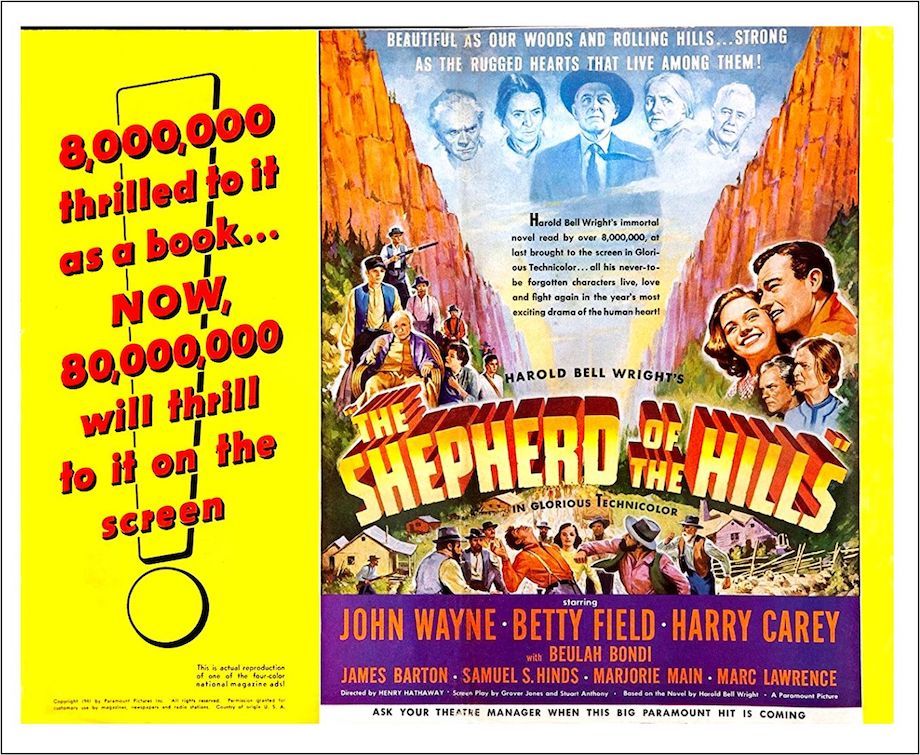
The Shepherd of the Hills (1941)
I had to include the face-off between Duke and Harry Carey Senior from this film in the list because it caught me totally by surprise the first time I watched it a while back.
A permanently angry JW doesn’t take too kindly to stranger Carey, who turns out to be his father, so they eventually get to have it out. Slowly approaching each other in a meadow, JW raises his rifle to shoot, only to be outdrawn by dad, who unexpectedly plugs his son first.
Now call me old-fashioned, but when a father shoots his son you’d think he’d aim for an arm or a leg or something from which there’s a slight chance of recovery, but Carey is not so considerate, planting the bullet square in JWs belly.
Of course, being John Wayne he naturally recovers from the kind of wound that would kill any other man. He once said that he learned a lot from Harry Carey Senior. I’m assuming that included learning to draw first the next time around.
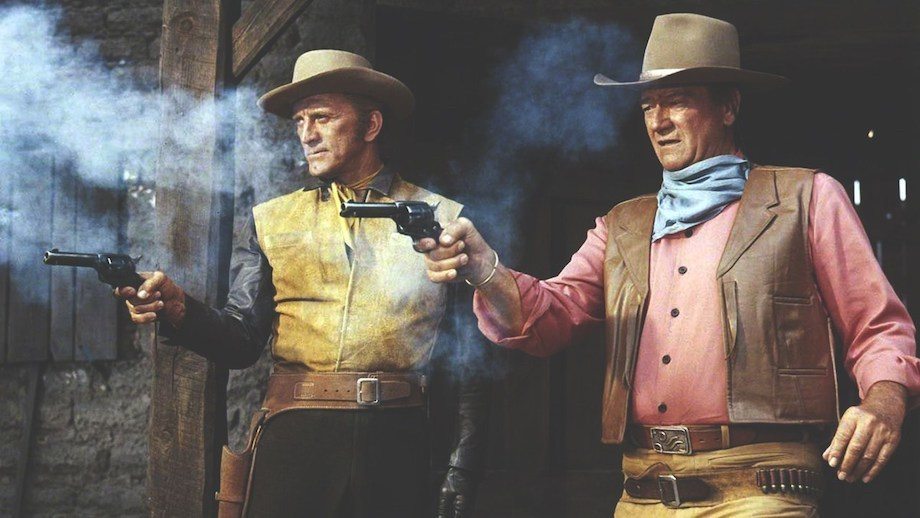
The War Wagon (1967)
Not exactly the most outstanding Wayne shootout if I’m honest, but watching JW and Kirk Douglas gun down a couple of hired killers is always a pleasure to behold when there’s nothing else on TV.
They say that hindsight is a wonderful thing, and it sure as hell would have been for John Wayne if he’d plugged Bruce Dern first off when he had the chance.
Instead, Kirk Douglas got to shoot him instead and obviously missed, because the “vermin-ridden son-of-a-bitch” that turned out to be Mr. Dern, or Hammond as he’s called here, just upped and changed his name to Asa Watts and ended up leading a bunch of low-down no good rustlers who would put our boy six feet under a few years later in The Cowboys.
It’s quite ironic that Wayne’s choice of target happens to be Chuck Roberson, who was also JWs stand-in at the time.
I did like the exchange between Douglas and Wayne after the gunfight though. Douglas claims ‘mine hit the ground first’. Wayne goes one better and tells Douglas that ‘mine was taller’.

Stagecoach (1939)
I’ve already referenced in previous articles the climactic shootout at the end of Stagecoach, in which John Wayne as the Ringo Kid administers frontier to the mangy Plummer gang who done killed his brother.
What I’ve not really addressed before is the atmospheric use of shadows and light employed by director John Ford to elevate the sequence from the mundane to the truly memorable, a style he employs to similar effect in The Man Who Shot Liberty Valance, more of which later.
The three – doomed – members of the Plummer gang emerge from one end of the darkly lit street into the light, after which JW slowly slips from out of the shadows in front of them.
Armed with his trusty Winchester, hopefully not the one he would use later in The Shepherd of the Hills, JW strides purposefully towards the gang, then throws himself to the ground, shooting as he goes.
Ford then cuts away from the action, leaving the audience pondering the fate of the Ringo Kid. It’s only when Luke Plummer, the gang leader, walks into the saloon then falls down dead that we realise the Kid has won through.
A great end to a truly great film.
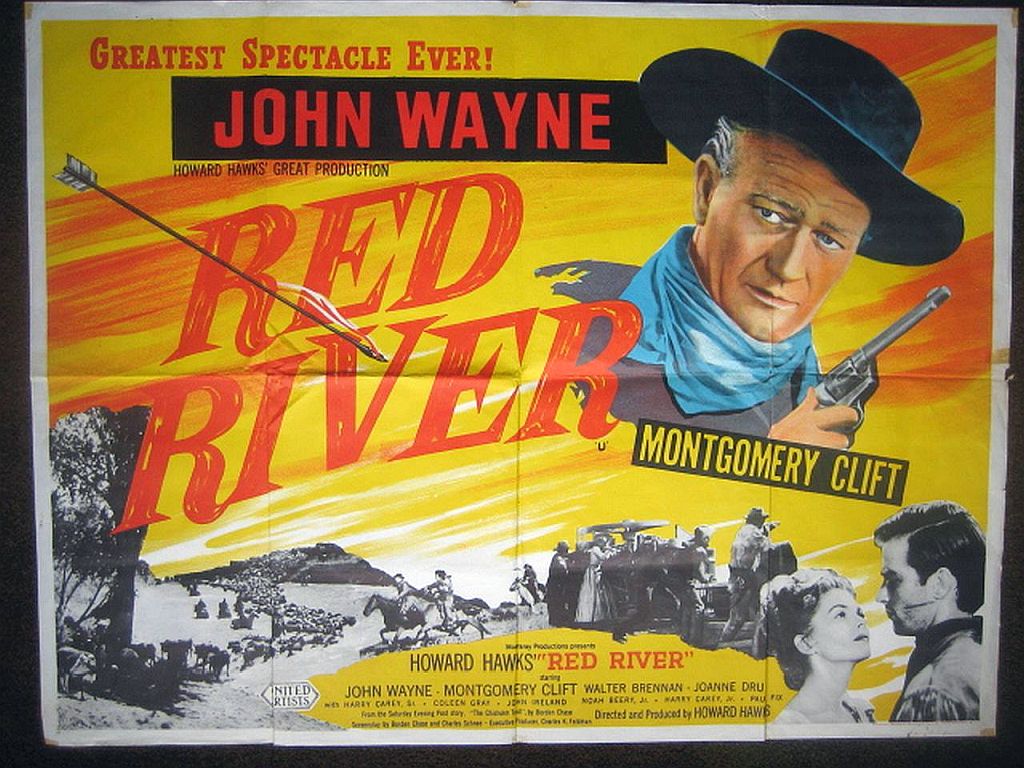 Red River (1948)
Red River (1948)
Having already singled out the gunfight that takes place between John Wayne and John Ireland towards the end of the film as a memorable moment in Wayne’s work, I thought I’d select an earlier sequence from the film instead.
Wayne, becoming increasingly more nasty and paranoid as tough trail boss Matt Dunson takes on three of his men who have decided to desert the ship, so to speak.
Watching it again I noticed that the trio is lead by none other than Tom Tyler, who also came to a sticky end courtesy of Duke in Stagecoach.
Dunson is initially unarmed but what Tyler and his compadres don’t realise is that Walter Brennan is sat out of sight ready to throw a loaded rifle Dunson’s way. Dunson catches the weapon and sends the trio to hell, with no return ticket.
He then calls out the rest of the cowboy herders, telling them he ‘hates quitters, especially those not good enough to finish what they started’.
It’s a seminal moment in the film because Dunson’s actions here initiate the eventual ‘mutiny’ in which his herd is taken away from him.
Not that I’m qualified to give the great man sage advice when it comes to gunplay, but sometimes you just have to shoot, shut up and walk away.
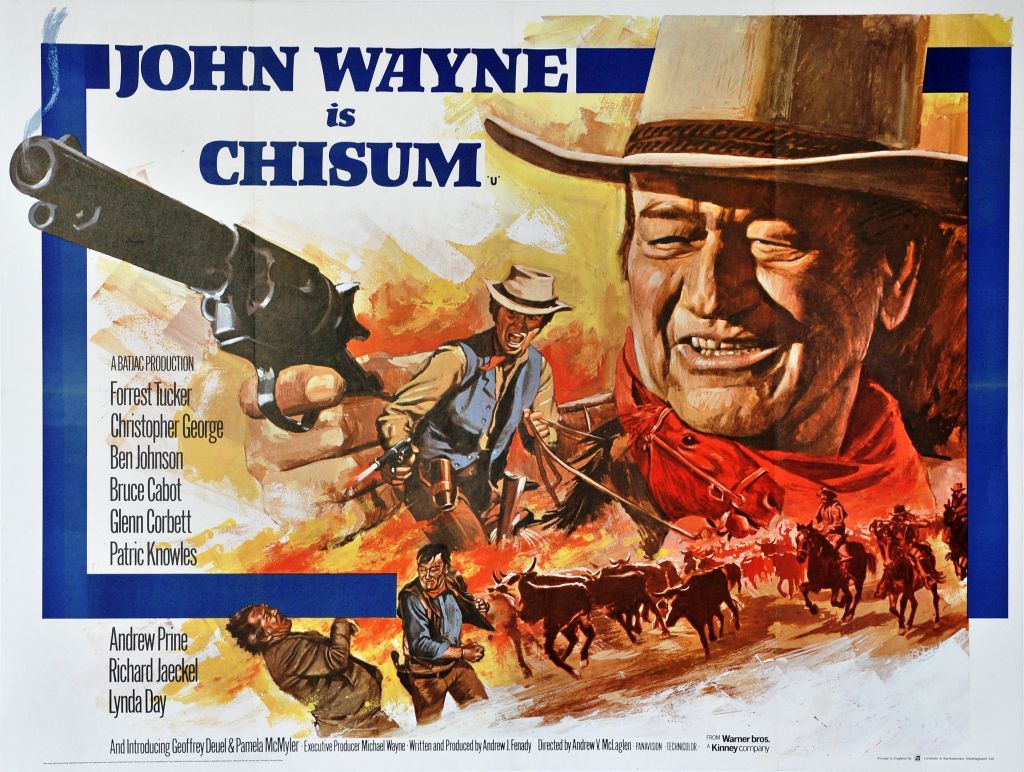 Chisum (1970)
Chisum (1970)
I do love a good old ‘laughing Mexican stand-off’ scene, and Chisum contains the only example of a sequence such as this in which John Wayne gets the chance to strut his stuff.
Catching up with the rustlers who have taken his horses, Chisum is greeted by a whisky-swilling south of the border sort who attempts to put JW off his stride with a grin as wide as a Cinemascope screen, but of course, it doesn’t work.
It never does.
After a brief exchange in which the Mexican rustler, played by one Lloyd Battista if I’m correct, asks if Chisum has brought any gold or silver along with him to repurchase his own horses. Chisum replies ‘No. Just lead’ and then pays the gentleman in kind.
JWs co-stars, including the great Ben Johnson, take out the rest of the gang, but, as ever, it’s Duke’s show. And don’t none of you forget it.
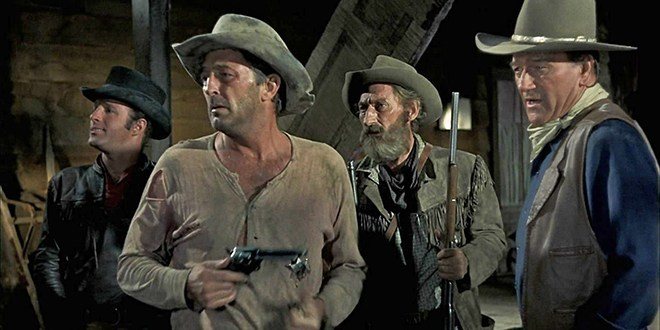
El Dorado (1966)
There’s more than one good shootout sequence in this Howard Hawks / JW movie.
I was tempted to go for the confrontation in the saloon between Robert Mitchum’s sheriff, J.P. Harrah and villain Bart Jason, played by Ed Asner, but seeing as Duke was just a bystander in that scene I’ve opted for the showdown between him and hired gun Nelson McLeod, played by Christopher George.
The “professionalism” that both Wayne and Hawks felt was missing in the Gary Cooper film, High Noon, in which Coop calls on the townspeople to help him once Frank Miller hits town, was one of the reasons they made Rio Bravo, a riposte to the politics of Carl Foreman’s script for the film.
Both Wayne and Hawks keep that theme running in El Dorado when Wayne’s character, Cole Thornton, turns up to confront McLeod with a paralysed right hand on account of a bullet lodged in his spine. McLeod points out that Thornton’s “gun hand is no good”. The following dialogue ensues.
[Thornton] “You just give me time to get down off this wagon and we’ll find out”
[McLeod] “Why should I give you any time?”
[Thornton] “Call it professional courtesy”
And that’s where McLeod makes his mistake.
As Eli Wallach, Tuco the bandit, says in The Good, the Bad and the Ugly, “when you have to shoot, shoot. Don’t talk!”.
Thornton leaps from the wagon, plugs McLeod – professionally – four times in the gut, takes some buckshot from a stray bullet courtesy of James ‘Mississippi’ Caan in the leg, before shooting another bad guy.
Not bad for a one-armed cripple, I’d say.
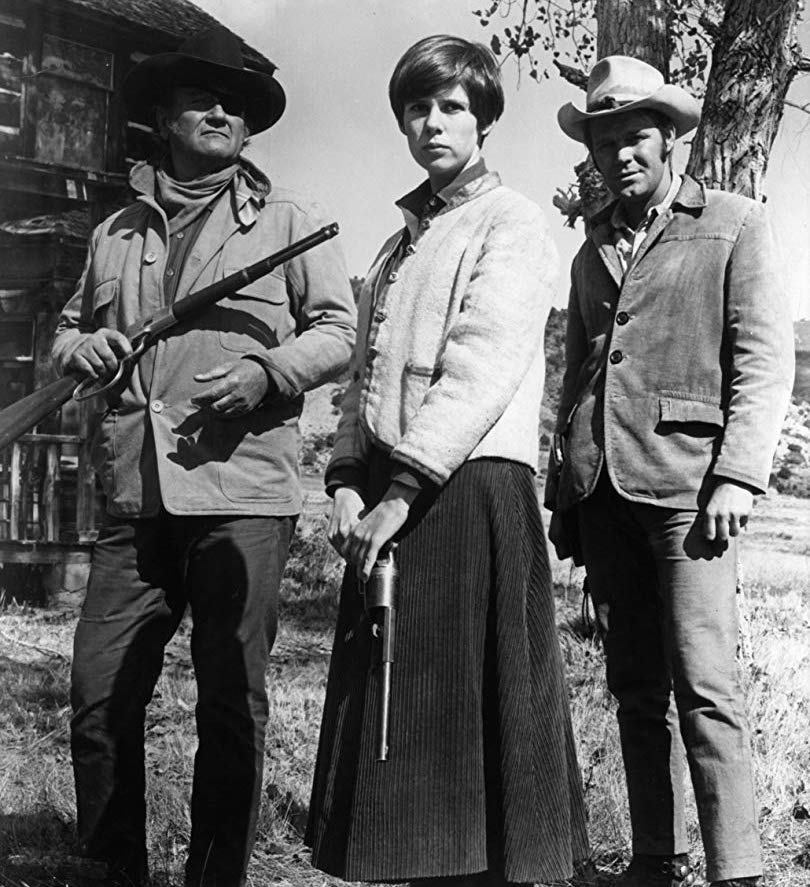
True Grit (1969)
If you’re looking for a classic John Wayne shootout then it doesn’t get more classic then this. The top-notch script helps as well, the exchange between Rooster and Ned Pepper probably one of the most-quoted of all Wayne movies:
[Rooster] I mean to kill you in one minute, Ned, or see you hang in Fort Smith at Judge Parker’s convenience. Which shall it be?
[Ned] I call that bold talk for a one-eyed fat man.
[Rooster] Fill your hands, you son-of-a-bitch!
Instead of taking aim at Pepper and the other three members of the gang with his trusty Winchester, Rooster grabs the reins in his mouth then gallops hell for leather towards the outlaws, blasting away with both rifle and handgun.
I notice Rooster / Wayne gets two of the men in the back, although I guess that’s allowed seeing as they’re trying to do him in as well.
One of the four rides off, leaving Rooster and Ned to face each other down. Ned shoots Rooster’s horse, which falls and traps him by the leg.
Just as Pepper raises his gun to finish Rooster off, the Rhinestone Cowboy himself, Glen Campbell, comes to the rescue and shoots Ned Pepper from way up on the bluff.
Not that anyone was ever in any real danger. After all, it’s only make believe – and I promise that’s the last Glen Campbell song I’m going to try and shoehorn in.
What also makes this such a great scene is both the spectacular Colorado locations used by director Henry Hathaway and Elmer Bernstein’s wonderful soundtrack.
All-in-all a great late career moment for Mr. Wayne.
And he won an Oscar too. Not bad for a one-eyed fat man.
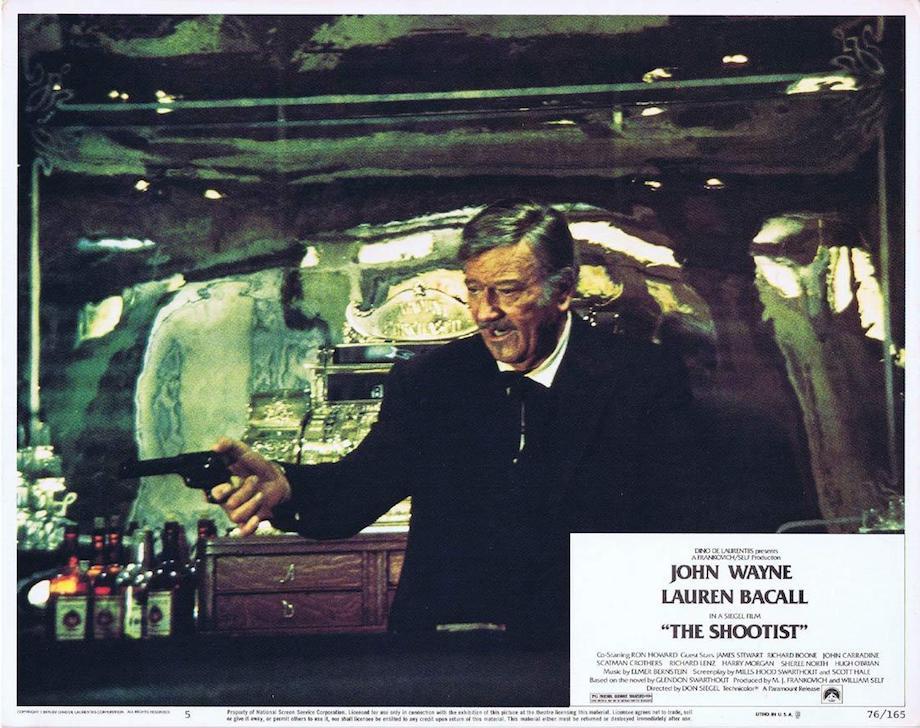
The Shootist (1976)
We all know how this is going to end for John Wayne – badly. It’s still a fairly intense sequence to watch though.
Famed gunslinger JB Books is dying, and all those with a grudge turn up at the local saloon to help put Books out of his misery. Cobb, Pulford and Sweeney, played respectively by Bill McKinney, Hugh O’Brien and Richard Boone, all take turns trying to finish JW off.
Books ascertains where the three are when he stands with his back to them in the saloon, watching their reflection in the mirror on the other side of the bar.
First up is Cobb who tries to shoot Books in the back. Books jumps behind the bar then administers two bullets-worth of lead poisoning to Mr. Cobb.
Up jumps Sweeney and shoots Books in the left shoulder.
Presumably, physics wasn’t exactly top of the school curriculum back in 1901 as Sweeney then inexplicably charges Books with a wooden table in front of him as a shield, unable to appreciate the tendency for bullets to go through wood. Two down, one to go.
Pulford lands another bullet in Books then creeps up to the front of the bar, both men aiming to finish the duel off.
Books catches Pulford’s reflection in a glass on the bar and waits as Pulford sticks his head out before planting a bullet between the eyes.
Then it gets nasty, with a bullet-ridden Books dispatched with two blasts of a shotgun by, of all people, the bartender.
Arriving just a little bit too bloody late, Ron ‘Richie Cunningham’ Howard takes out the bartender before throwing the gun away, indicating that the whole blood-thirsty gun slaughter thing isn’t for him.
Books nods silently in agreement then expires. It’s as good an action sequence that one might expect from Dirty Harry director Don Siegel, so I’d say that director, script, supporting cast and Elmer Bernstein’s soundtrack served Mr. Wayne well in his final film.
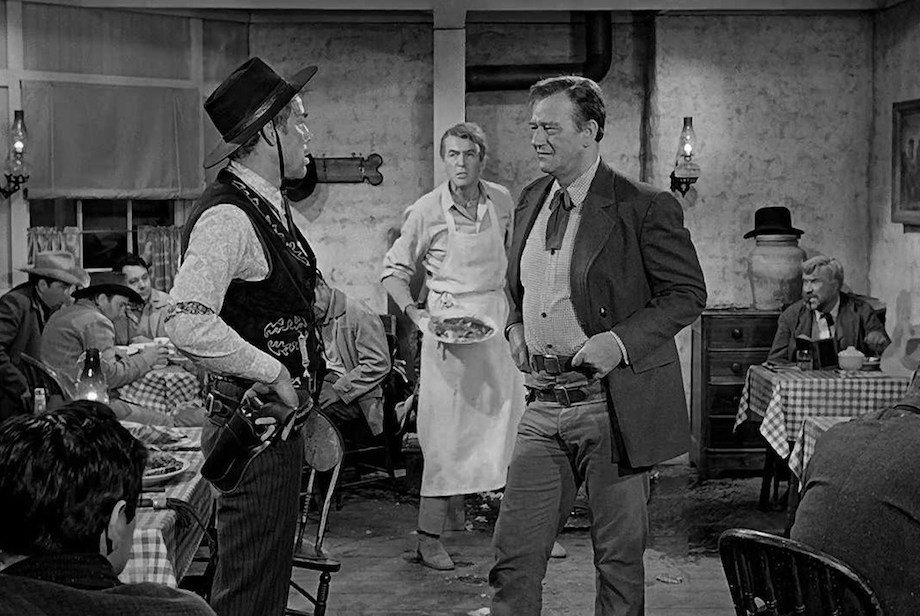
The Man Who Shot Liberty Valance (1962)
Two shootouts for the price of one – and it’s a John Ford movie too.
Although the three-way duel between Rance Stoddard (James Stewart), Valance (Lee Marvin) and Tom Doniphon (John Wayne) is obviously filmed on a studio set, the shadowy showdown is highly reminiscent of the climactic Ringo Kid / Plummer gang confrontation at the end of Stagecoach.
And Lee Marvin, along with Henry Brandon, drips pure evil like no other villain in a John Wayne movie. He’s a sadistic bully who prolongs Stewart’s pain by first shooting him in the arm, firing at Stewart as the wounded man reaches for his gun on the ground, before aiming at his opposite number and promising to put a bullet “right between the eyes”.
Surprisingly, Stewart manages to get out a lucky shot and Valance drops in the dirt.
There’s a touch of a Brokeback Mountain moment when the death of the villain is greeted by quite a plaintive cry from Floyd, one of Valance’s cronies, played by the ever-reliable Strother Martin, but maybe that’s just me giving full rein to my penchant for seeking out the hidden subtext that lurks beneath the surface of the narrative.
Then it gets complicated because lo and behold, it turns out things are not what they seem.
Doniphon later spills the campfire beans to Stoddard, who in the meantime has turned his fame as the killer of Valance into a political career, snaffling Doniphon’s gal, Hallie, in the process. Beings as this is JW we’re talking about, he doesn’t beat about the bush, he just comes right out and says:
“You didn’t kill Liberty Valance – think back, Pilgrim”
We then see the confrontation from Doniphon’s perspective, standing in the alleyway across from the street and putting a bullet into Valance the same time Stoddard fires.
It’s interesting to see that Doniphon waits while Valance wounds Stoddard before finishing the gunfight off.
Rule number one: don’t play around with JWs gal. It might get you shot.
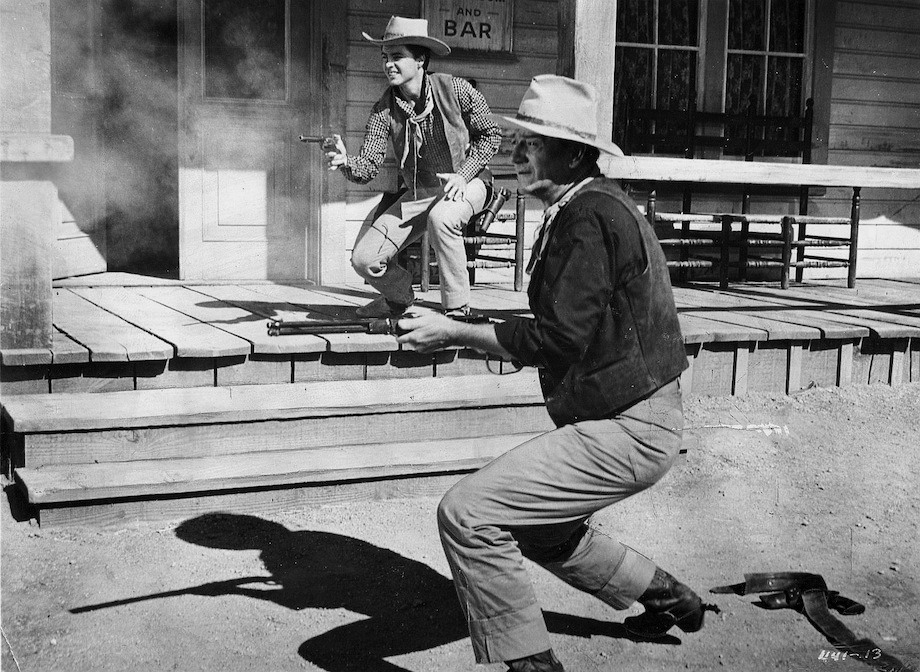 Rio Bravo (1959)
Rio Bravo (1959)
Unless the protagonists are dancing to an Ennio Morricone soundtrack, a subject I’m going to leave for another time, a cowboy shootout has to be short, sharp and to the point – and the bad guy has to die at the end.
Although not the climactic sequence to Rio Bravo, I nominate the face-off between John T. Chance and Colorado on one side, and the three Nathan Burdette goons on the other, as my favourite JW shootout scene.
Rio Bravo is quite a long film, and the action sequences are few and far between but when they do come along they’re well worth waiting for.
The bad guys get the drop on Chance out in the street, forcing him to drop his gun belt before ordering him to let Joe Burdette out of jail.
Colorado saunters out onto the street from the local hotel, previously having overheard the confrontation outside and priming Feathers to throw a vase through the window in order to distract the villains.
When the plant sails through the window, Colorado throws Chance his trusty Winchester Model 1892 Saddle Ring Carbine – the stuff you can find out on the internet these days is absolutely phenomenal – and the two of them gun the varmints down, Chance also putting another notch on his rifle by shooting an extra baddie at the end of the street.
A few things to mention about this scene. First off, it gives Colorado the chance to redeem himself with Chance after having turned down a request for help from the beleaguered sheriff.
He’s now part of the group, whether he likes it or not, along with Stumpy and Dude, tasked with fending off Burdette and his men until the Marshal arrives, so we’re now reassured everything is going to work out fine for the good guys – and he can sing too.
Secondly, the scene takes part the morning after a night of passion between Chance and Feathers so what with him being somewhat tired and worn out to say the least, I’m guessing Chance would have appreciated all the help he could get.
Thirdly, the hat worn by the villain on the right is so ridiculously outlandish – he looks as though he’s just mugged Tom Mix and stolen it from him – the man deserves to die purely for crimes against cowboy fashion.
Also, I love the fact that the hotel Colorado emerges from is called The Alamo.
Not only does it bring to mind the fact that Chance and his group are under siege in the jailhouse throughout most of the film, but Wayne gets free publicity for his next directorial effort. What’s not to like?
